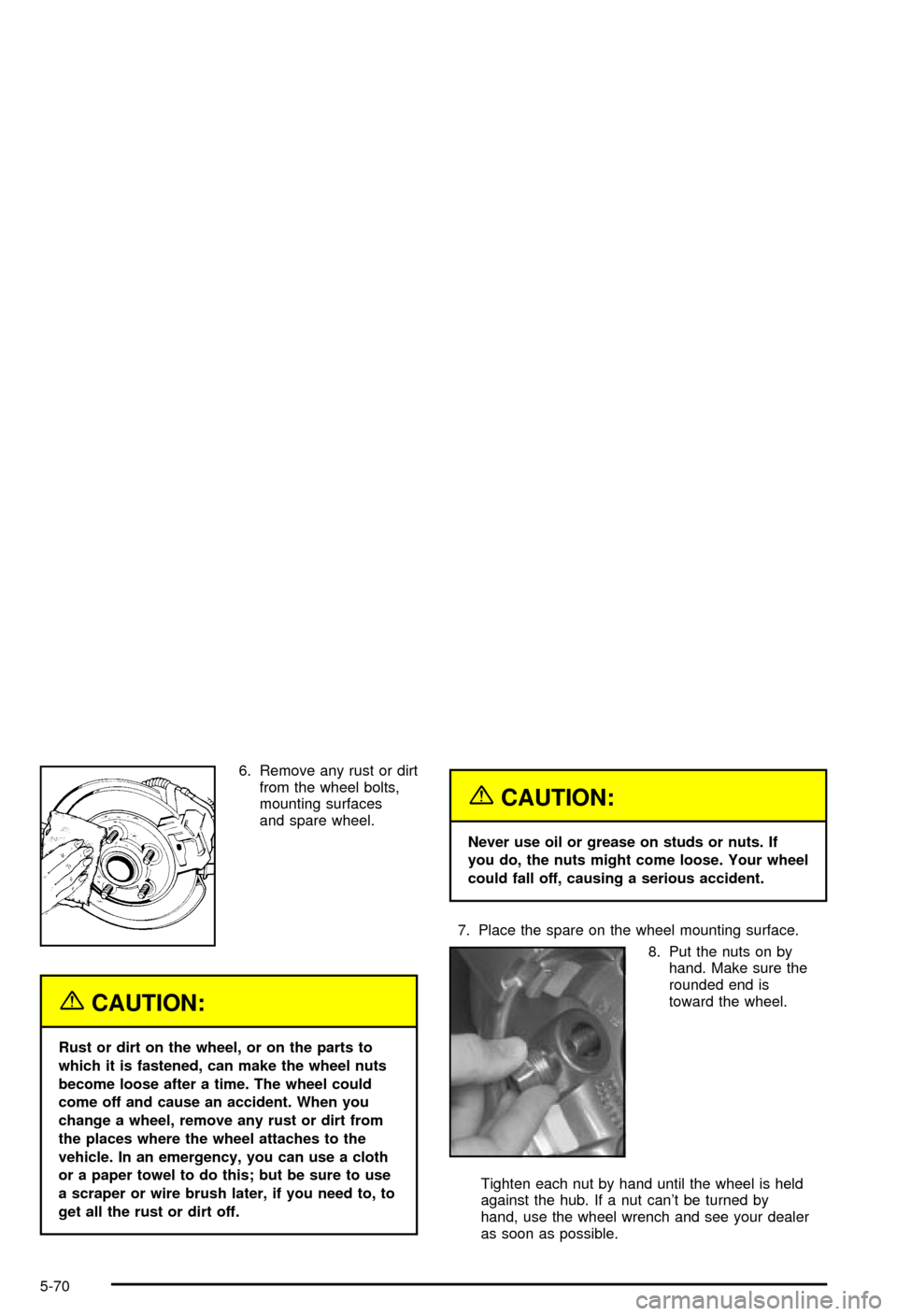2003 CHEVROLET BLAZER change wheel
[x] Cancel search: change wheelPage 326 of 420

Tire Chains
{CAUTION:
Don't use tire chains. There's not enough
clearance. Tire chains used on a vehicle
without the proper amount of clearance can
cause damage to the brakes, suspension or
other vehicle parts. The area damaged by the
tire chains could cause you to lose control of
your vehicle and you or others may be injured
in a crash. Use another type of traction device
only if its manufacturer recommends it for use
on your vehicle and tire size combination and
road conditions. Follow that manufacturer's
instructions. To help avoid damage to your
vehicle, drive slowly, readjust or remove the
device if it's contacting your vehicle, and don't
spin your wheels. If you do ®nd traction
devices that will ®t, install them on the
rear tires.
If a Tire Goes Flat
It's unusual for a tire to ªblowoutº while you're driving,
especially if you maintain your tires properly. If air goes
out of a tire, it's much more likely to leak out slowly.
But if you should ever have a ªblowout,º here are a few
tips about what to expect and what to do:
If a front tire fails, the ¯at tire will create a drag that
pulls the vehicle toward that side. Take your foot off the
accelerator pedal and grip the steering wheel ®rmly.
Steer to maintain lane position, and then gently brake to
a stop well out of the traffic lane.
A rear blowout, particularly on a curve, acts much like a
skid and may require the same correction you'd use
in a skid. In any rear blowout, remove your foot from the
accelerator pedal. Get the vehicle under control by
steering the way you want the vehicle to go. It may be
very bumpy and noisy, but you can still steer. Gently
brake to a stop, well off the road if possible.
If a tire goes ¯at, the next part shows how to use your
jacking equipment to change a ¯at tire safely.
5-62
Page 327 of 420

Changing a Flat Tire
If a tire goes ¯at, avoid further tire and wheel damage
by driving slowly to a level place. Turn on your
hazard warning ¯ashers.
{CAUTION:
Changing a tire can cause an injury. The
vehicle can slip off the jack and roll over you
or other people. You and they could be badly
injured. Find a level place to change your tire.
To help prevent the vehicle from moving:
1. Set the parking brake ®rmly.
2. Put the shift lever in PARK (P).
3. Turn off the engine.
To be even more certain the vehicle won't
move, you can put blocks at the front and rear
of the tire farthest away from the one being
changed. That would be the tire on the other
side of the vehicle, at the opposite end.The following steps will tell you how to use the jack and
change a tire.
Removing the Spare Tire and Tools
The jacking equipment you'll need is stored along the
driver's side inner rear quarter panel. In some cases,
you may have to remove the spare tire in order to reach
the jack. Your vehicle is also equipped with work
gloves and a plastic ground mat to assist in the changing
of a ¯at tire.
5-63
Page 334 of 420

6. Remove any rust or dirt
from the wheel bolts,
mounting surfaces
and spare wheel.
{CAUTION:
Rust or dirt on the wheel, or on the parts to
which it is fastened, can make the wheel nuts
become loose after a time. The wheel could
come off and cause an accident. When you
change a wheel, remove any rust or dirt from
the places where the wheel attaches to the
vehicle. In an emergency, you can use a cloth
or a paper towel to do this; but be sure to use
a scraper or wire brush later, if you need to, to
get all the rust or dirt off.
{CAUTION:
Never use oil or grease on studs or nuts. If
you do, the nuts might come loose. Your wheel
could fall off, causing a serious accident.
7. Place the spare on the wheel mounting surface.
8. Put the nuts on by
hand. Make sure the
rounded end is
toward the wheel.
Tighten each nut by hand until the wheel is held
against the hub. If a nut can't be turned by
hand, use the wheel wrench and see your dealer
as soon as possible.
5-70
Page 388 of 420

Throttle System Inspection
Inspect the throttle system for interference or binding,
and for damaged or missing parts. Replace parts
as needed. Replace any components that have high
effort or excessive wear. Do not lubricate accelerator
and cruise control cables.
Transfer Case and Front Axle
(Four-Wheel Drive) Inspection
Every 12 months or at engine oil change intervals,
check front axle and transfer case and add lubricant
when necessary. A ¯uid loss could indicate a problem;
check and have it repaired, if needed. Check vent
hose at transfer case for kinks and proper installation.
More frequent lubrication may be required on
off-road use.
Brake System Inspection
Inspect the complete system. Inspect brake lines and
hoses for proper hook-up, binding, leaks, cracks,
cha®ng, etc. Inspect disc brake pads for wear and rotors
for surface condition. Also inspect drum brake linings
for wear and cracks. Inspect other brake parts, including
drums, wheel cylinders, calipers, parking brake, etc.
Check parking brake adjustment. You may need to have
your brakes inspected more often if your driving
habits or conditions result in frequent braking.
6-32
Page 419 of 420

Tow/Haul Mode...............................................2-26
Towing..........................................................4-45
Recreational Vehicle.....................................4-45
Towing a Trailer..........................................4-54
Your Vehicle...............................................4-45
Trailer Brakes.................................................4-60
Trailer Wiring Harness.....................................4-65
Transfer Case and Front Axle (Four-Wheel Drive)
Inspection...................................................6-32
Transfer Case................................................5-45
Transmission Operation, Automatic....................2-23
Transmission Operation, Manual........................2-27
Transmission, Transaxle, Transfer Case Unit
Repair Manual............................................7-11
Transmission..................................................5-17
Fluid, Automatic...........................................5-17
Fluid, Manual..............................................5-20
Up-Shift Light..............................................3-27
Transportation Options...................................... 7-8
Traveling to Remote Areas...............................4-17
Trip Odometer................................................3-24
Turn and Lane-Change Signals.......................... 3-5
Turn Signal/Multifunction Lever........................... 3-5
Turn Signals When Towing a Trailer..................4-62
U
Underbody Flushing Service.............................6-30
Understanding Radio Reception........................3-69Uniform Tire Quality Grading............................5-59
United States ± Customer Assistance.................. 7-5
Up-Shift Light.................................................2-28
Used Replacement Wheels..............................5-61
Using HomeLink
ž...........................................2-47
Using RDS....................................3-43, 3-51, 3-60
Using Song List Mode.....................................3-66
Using the Recovery Hooks...............................4-43
V
Vehicle Identi®cation........................................5-83
Number (VIN).............................................5-83
Service Parts Identi®cation Label...................5-84
Vehicle Personalization....................................2-61
Memory Seat..............................................2-61
Vehicle Storage..............................................5-40
Vehicle............................................................ 4-7
Control........................................................ 4-7
Damage Warnings........................................... iv
Design......................................................... 4-3
Loading......................................................4-52
Parking Your...............................................2-38
Symbols......................................................... iv
Ventilation Adjustment......................................3-20
Visors...........................................................2-16
Voltmeter Gage..............................................3-27
15
Page 420 of 420

W
Warning Lights, Gages and Indicators................3-21
Warnings......................................................... 3-3
Hazard Warning Flashers............................... 3-3
Other Warning Devices.................................. 3-4
Safety and Symbols......................................... iii
Vehicle Damage.............................................. iv
Washing Your Vehicle......................................5-79
Weatherstrip Lubrication...................................6-27
Weight of the Trailer Tongue.............................4-58
Weight of the Trailer........................................4-56
What Kind of Engine Oil to Use........................5-13
What to Add..................................................5-38
What to Do with Used Oil................................5-15
What to Use..................5-23, 5-35, 5-36, 5-45, 5-47
Wheels and Tires............................................5-91
Wheels..........................................................5-60
Alignment and Tire Balance..........................5-60
Replacement...............................................5-60
When to Add Engine Oil..................................5-12
When to Change Engine Oil.............................5-14
When to Check and Change Lubricant.......5-45, 5-46
When to Check and Change............................5-17
When to Check and What to Use.....................5-21
When to Check Power Steering Fluid................5-35
When to Check......................................5-20, 5-56
When to Inspect the Engine Air
Cleaner/Filter..............................................5-16When You Are Ready to Leave After
Parking on a Hill.........................................4-64
Where to Put the Restraint...............................1-41
Why Safety Belts Work....................................1-10
Window Lockout.............................................2-12
Windows.......................................................2-11
Power........................................................2-12
Rear Window..............................................2-13
Swing-Out Windows.....................................2-13
Windshield Washer Fluid Level Check................6-26
Windshield Washer.........................................5-36
Fluid..........................................................5-36
Windshield Wiper............................................5-52
Blade Replacement......................................5-52
Fuses........................................................5-85
Windshield Wipers............................................ 3-6
Winter Driving................................................4-38
Wiper Blade Check.........................................6-27
Y
Your Driving, the Road, and Your Vehicle............. 4-2
Your Vehicle and the Environment....................... 6-2
16